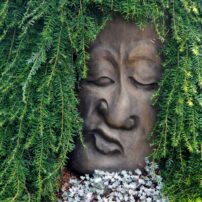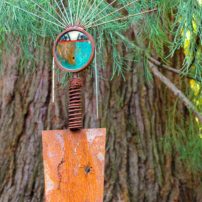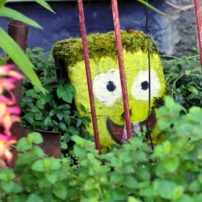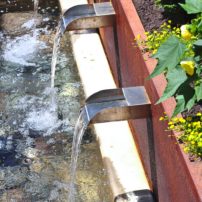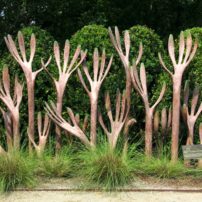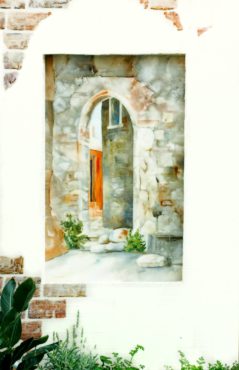
Art is an integral part of our lives and is present in our homes, landscapes and public spaces. Gardens have long been a place for art installations, a practice that dwells in history. Even ancient gardens needed structures, and out of that need came creativity.
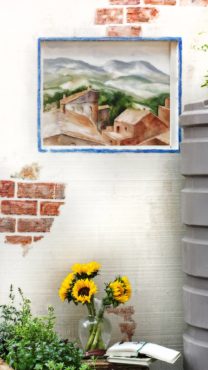 Inspiration turned garden structures into garden features — walls, paths, water sources, water tanks and carriers, benches, plant containers, baskets for harvest and shelters from the sun. As long as there has been a garden need, someone came along with a vision to make the solution a garden feature.
Inspiration turned garden structures into garden features — walls, paths, water sources, water tanks and carriers, benches, plant containers, baskets for harvest and shelters from the sun. As long as there has been a garden need, someone came along with a vision to make the solution a garden feature.
What we know as art dates as far back as 30,000 B.C. Paintings in caves, sculptures of fertility goddesses and megalithic structures such as those found in Stonehenge still speak to us in the future and bring a sense of awe at what our ancestors accomplished in the past.
Garden art for a purpose is a delight, whether used as a focal point or destination. At the Northwest Flower & Garden Festival in Seattle, there are creative features installed in almost every display garden.
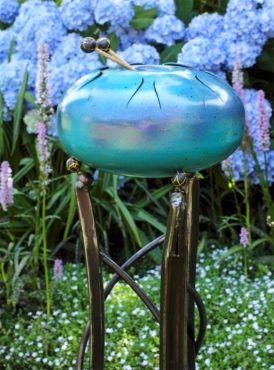
Garden designers know that decorative interests bring the eye to rest and set a mood and style. Art defines a design or becomes a focal point. It is a destination in the garden. Besides, art acts as a surprise — an interruption of the expected.
Art as a Statement
Art can also make a statement in the garden. At the North Carolina Botanical Garden in Asheville, one installation makes a grand statement about environmental issues. Martin Webster’s “A Hedge against Extinction” is a permanent installation to commemorate the first World Botanic Gardens Congress in 2000 that the arboretum hosted.
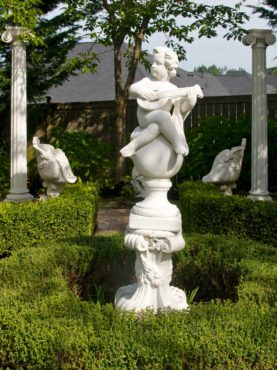
Another item to note about the sculpture: The art brought excitement to an otherwise bland environment.
The Interruption of the Expected
Garden art brings the element of surprise — the discovery of the unexpected. The fun of the find is not only for the visitor walking through the garden, but for the person placing it in anticipation of the reveal during the journey through the landscape.
One of the discoveries in the Oregon Garden in Silverton, Oregon, is a sculpted face. Planted under a conifer that stands in as hair for the piece, and it is a joy to find. The sculpture gives you pause. Is that a smirk or a grimace, or is he annoyed? How often does the conifer need a haircut?
A metal sculpture standing guard in front of a sequoia tree is another surprise and adds more questions. Is there a symbolic connection between the sculpture and the ancient sequoia?
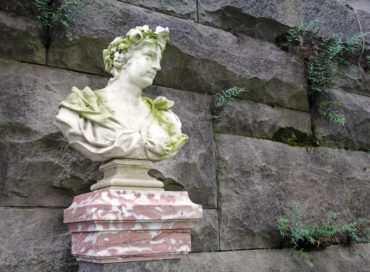
Funny little discoveries give away the garden owners’ playfulness. Sponge Bob found hiding in the bushes brings a giggle, especially if one knows the homeowner has a fondness for the cartoon character, so he made one for his garden. Is it art? Someone created the character so that the argument could be made — why not?
The unexpected is a copper frog jumping from a pot of plants to a larger container of water. In this garden, Pacific tree frogs pack up every spring and take over the garden with two ponds and numerous water features. The gardener plays tribute to them with frog art sprinkled throughout the garden.
Setting the Style and Mood
The selection of art and structures set the style in the garden. Formal classic gardens are common for large estates with super mansions. At the Biltmore Estates in Asheville, North Carolina, the gardens are homes for many statues and busts.
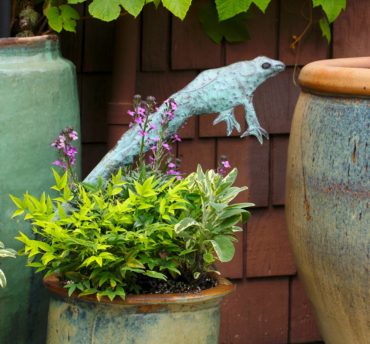 Four marble busts, each representing a season, line up against a fern-laden limestone wall under a long, wisteria-draped pergola. Initially built in 1891, the structure became a place to rest with a view of a lawn tennis court for the Vanderbilts and their friends.
Four marble busts, each representing a season, line up against a fern-laden limestone wall under a long, wisteria-draped pergola. Initially built in 1891, the structure became a place to rest with a view of a lawn tennis court for the Vanderbilts and their friends.
Smaller gardens in the Northwest also give homes to sculptures in formal settings.
Water Features
Water is the soul of the garden. Thousands of years ago, water was considered sacred because that is where the gods hung out. Water was an ancient tradition, central to the landscapes of many civilizations, from the Greeks to the Mayans.
Today, colossal waterfalls flow in cities and reflective pools remain motionless on grand estates, and even the tiniest gardens have fountains or birdbaths. Designed by artisans throughout history, water features bring another dimension to the garden. People flock to water — the sound of water soothes and reflection pools slow us down.
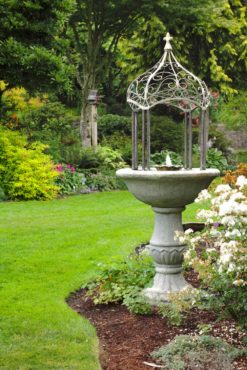
Trompe L’oeil
Trompe l’oeil is French for deceiving the eye. Commonly used to give the illusion of depth or space, in the garden trompe l’oeil helps cover plain walls or extend the garden visually. At the Northwest Flower & Garden Show in the “City Living Gardens,” one of the walls was an example of a painting that tricks the eye. Marilyn Jacobs designed the garden “Herbes/Fleurs de Provence” for Rain Dog Designs out of Gig Harbor.
Ephemeral Art
Temporary art enhances a garden setting during a gathering of friends in the garden. Establish a brief work of art by merely using the Balinese tradition of mandalas made of floating leaves and flower petals and flowers in intricate patterns in a birdbath.
A tongue drum placed on a stand in the garden has colors that echo its surroundings. Never left out in the elements to rust, the drum as a temporary display adds to the visual appeal of the space and creates amusement for guests. The included mallets invite visitors to engage in the melodious notes.
Without art, a piece of the heart is missing. Artistic features are as relevant today as they have been throughout the ages. A garden enhanced by artistic elements contributes to the spirit of the place.




